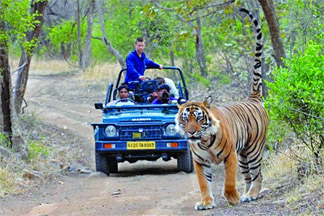The Ranthambore Tiger Reserve is among the world’s most prominent tiger reserves, serving as a sanctuary for the majestic Bengal Tiger species. The Ranthambore Tiger Reserve, situated in Sawai Madhopur in the northern Indian state of Rajasthan, is one of the largest tiger habitats in the country.
The Ranthambore National Park, along with the Ranthambore Fort and the surrounding hills and valleys, altogether make Ranthambore a traveller’s delight. The place is a boon for wildlife photographers and is perfect for excursions and sightseeing. Safari Rides add to the adventure along with hot Rajasthani picks for shopaholics. With an area of 392 kilometres square, Ranthambore National Park is a natural habitat for a variety of exotic species. It is an absolute delight for birdwatchers and an ideal place to watch animals in their natural habitat.
The Ranthambore Fort, built in the 10th century, stands tall over the entire National Park. Built by the Chauhan Dynasty, the Fort is a UNESCO World Heritage Site. Located inside the fort is the majestic temple of Lord Ganesha, the Trinetra Ganesh Temple. Ganesha devotees flock the temple throughout the year. The other two temples are dedicated to Lord Shiva and Ramlalaji respectively. Two Jain temples, devoted to Lord Sumatinath and Lord Sambhavnath are other attractions of the Fort. The Padam lake and the Surwal lake are two among many that are a haven for bird watching. The ideal time to visit these lakes is early morning. Located adjacent to the Padam lake is the Jogi Mahal, a red sandstone marvel. Kachida Valley, famous for locating panthers and bears, along with Raj Bagh Ruins and the surrounding deciduous forests altogether score brownie points for Ranthambore.
Ranthambore Tiger Reserve
Spread in an area of 392 sq. Km, the Ranthambore Tiger Reserve is one of the largest and famed tiger reserves in the country, famous for the magnificent Bengal Tiger found there. The Ranthambore Tiger Reserve derives its name from the Ranthambore Fort located in the region. Situated in the Sawai Madhopur district of Rajasthan, it forms a part of Project Tiger reserves, by the Government of India, set up in 1955. Ancient religious ruins found within the forest, surrounded by the rich biodiversity and aesthetically crumbling cenotaphs make Ranthambore Tiger Reserve a favourite spot for photographers, wildlife enthusiasts and travellers.
Among other things, the tiger reserve is known for the medieval hunting trips carried out by the royals of Jaipur when hunting a tiger was the symbol of valour. One can take a safari ride through the jungle and experience watching a tiger in its natural habitat from a few metres away. Dry deciduous forests and marshy grassland forms a distinctive feature of this place with the Aravalli Range and Vindhya Plateau surrounding it to set it apart from the strikingly different desert in the very same state. The Ranthambore Tiger Reserve is also home to a wide variety of flora and fauna. The Sawai Man Singh Sanctuary and Kaldevi Sanctuary that surrounds this tiger reserve became part of the tiger reserve project in the 1990s.
Jeep Safari
Jeep Safari is the best way to explore the various zones of the Ranthambore National Park. Wildlife photographers and bird watchers often opt for these safaris to capture thrilling moments in the National Park. Jeep safaris need to be booked well in advance to ensure availability.
Ranthambhore Fort
Ranthambhore Fort is a magnificent fort erected by a ruler belonging to the Chauhan Royal family located in Ranthambhore in Rajasthan. The regal fort is said to have existed since the 12th century and is a perfect tourist attraction for those wanting to explore Royal Rajasthan. The splendid fort of Ranthambhore stands strong amidst dense forests that form the Ranthambhore National Park. The view of the fort from the national park and the view of the dense forest from the top of the fort are both worth seeing. As one explores the magnificent structure, they are bound to experience the magnificent vibe that the fort radiates in the warm sunlight of Rajasthan.
Ranthambore Fort has been declared as a World Heritage Site by UNESCO and is an important Hill Fort of Rajasthan. The dense forest that forms the Ranthambhore National Park was once the hunting ground of the royalty that lived here. The fort is surrounded by a massive wall and has strong stone pathways and staircases that lead to the top portion of the structure. As you trek upwards; do notice the traditional Rajasthani architecture with massive gates, pillars, domes, palace and temples. The reserve is home to some birds and animals. Tourists will usually find a lot of monkeys in and around the fort; however, if you are lucky, you may also be presented with the beautiful peacocks living in the National Park.
Surwal Lake
A beautiful natural water body, Surwal Lake is a treat to the tired eyes. It is located inside the Ranthambore National Park and the mesmeric surroundings make the attraction worth a visit. The region is also famous for bird watching and one can observe a number of migratory birds during the winter season.
Ranthambore: A sanctuary for the majestic Bengal Tiger
